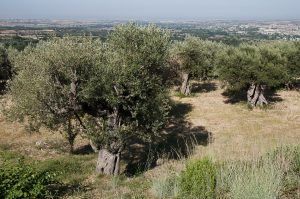Train and bikes
Condividi
This is a short easy itinerary through one of the most well known and attractive towns in Lazio. This scenic route winds its way through the city and its neighbourhood and offers wonderful views of the lower part of the Aniene valley. Visitors can also choose to continue on foot and visit the Riserva Naturale del Monte Catillo(Monte Catillo Nature Reserve), whose summit offers a beautiful panorama of Tivoli and the plain at its feet.
 Tivoli can be reached via the Roma Tiburtina-Tivoli line (get off at the Guidonia Montecelio stop). Take the road to the right towards Villa Gregoriana (see next itinerary) and enter the city. Cross the Ponte Gregoriano, which offers a picturesque view of Roman temples built high above the Aniene waterfalls: this was one of the main stops for visitors who came to Italy on the “Grand Tour”, and is immortalised in hundreds of prints and paintings, as are the impressive waterfalls below. The sacred area consists of a rectangular and a round temple. The first allegedly is the temple of Tiburno, the mythical founder of the city, and the second probably is the temple of the Sibilla Albunea or Tiburtina, a famous priestess who used to be questioned to know the will of the gods.
Tivoli can be reached via the Roma Tiburtina-Tivoli line (get off at the Guidonia Montecelio stop). Take the road to the right towards Villa Gregoriana (see next itinerary) and enter the city. Cross the Ponte Gregoriano, which offers a picturesque view of Roman temples built high above the Aniene waterfalls: this was one of the main stops for visitors who came to Italy on the “Grand Tour”, and is immortalised in hundreds of prints and paintings, as are the impressive waterfalls below. The sacred area consists of a rectangular and a round temple. The first allegedly is the temple of Tiburno, the mythical founder of the city, and the second probably is the temple of the Sibilla Albunea or Tiburtina, a famous priestess who used to be questioned to know the will of the gods.
You can reach the Belvedere by continuing your route through the city: this is a public park with a magnificent view of Rome. If you follow the road back, you will find the Villa Gregoriana; turn left into Via Quintilio Varo, a panoramic road leading to Marcellina. Once you reach a marble arch you can see, to the right, a well-marked path leading to the Riserva Naturale del Monte Catillo. This scenic route then continues with several gradients, due to hillside bends, and twice crosses the arches of the Rome-Pescara railway line, offering fine glimpses of the Aniene’s smaller waterfalls. Visitors will then reach the Palombara Sabina stop, the old Palumbaria which spiralled up a hill: it was once part of the Savelli family fiefdom, as well as of the Borghese and Torlonia families’ domain. The San Biagio church on the main square still has a painting by Antonio da Viterbo, while at the entrance of the town stands the small church of the Annunziata, with an Annunciation by Antoniozzo Romano. By following a path to the left of the church you can take a 30-minute detour to see the S. Giovanni in Argentella church, passing through thick olive groves and a valley of cherry trees. This small Romanesque church was part of an old convent which has now been destroyed. It has a bell-tower with triple lancet windows and an apse decorated with small arches, while the façade has an entrance portico with Roman bas-reliefs and a shrine with a Byzantine Madonna. Inside the church there are 14th century frescoes and an extremely rare iconostasis in the Cosmati style.
Once you return to the station of Palombara, take the pedestrian crossing across the railway tracks and continue straight on, up a short slope followed by a deep narrow valley. Once you reach the fork in the road close to a railway bridge, turn left up another short slope and border the tracks until you reach the asphalt road. Close to some laboratories, cross another railway bridge and turn left. Once you reach the main road for Palombara, head towards Guidonia and its railway station.
| By train: | Outward journey: Roma Tiburtina-Tivoli line Return: Guidonia/Montecelio-RomaTiburtina line |
| By bicycle: | Length: about 14 km Difficulty: very easy |
Information
www.parchilazio.it
R. Pugliesi, Lazio. Treni & bici. Il Lazio Settentrionale, Padova 2000.